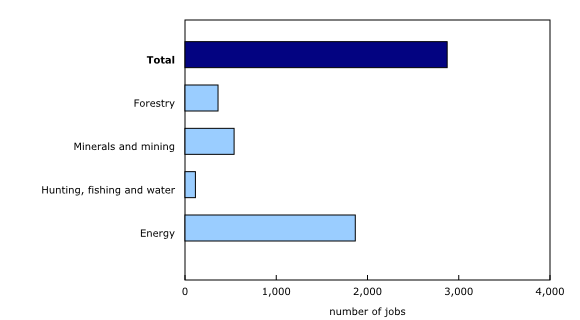Natural resource indicators, second quarter 2019
Archived Content
Information identified as archived is provided for reference, research or recordkeeping purposes. It is not subject to the Government of Canada Web Standards and has not been altered or updated since it was archived. Please "contact us" to request a format other than those available.
Released: 2019-09-25
Natural resources gross domestic product rebounds
Real gross domestic product (GDP) for the natural resources sector rose 3.6% in the second quarter, after falling for two consecutive quarters. This upturn was driven by a substantial increase in crude oil and bitumen extraction.
By comparison, real GDP for the total economy advanced 0.9%, after edging up 0.1% in each of the two previous quarters.
Growth in the energy subsector was attributable mainly to a 7.6% rise in crude oil and bitumen extraction. Higher prices, coupled with continued easing of the production limits adopted by the Alberta government in January 2019, boosted the growth.
The minerals and mining subsector rebounded 1.5%, after two quarterly declines. Metallic mineral extraction was up 6.5%, largely due to increased mining of copper, nickel, lead, and zinc. Non-metallic mineral extraction declined 0.3%.
After three quarterly contractions, the forestry subsector rose 0.6%. A 2.1% rise in sawmill and wood products coincided with increased housing investment in the quarter. The increase in sawmill and wood products was offset by a 2.7% decline in pulp and paper products, the fourth consecutive quarterly decrease. Hunting, fishing and water edged up 0.4%, after two quarterly declines.
Exports of natural resources grow
Natural resources export volumes rose 3.9% in the second quarter, after two quarterly declines. Both exports of energy (+5.7%) and exports of mineral resources (+3.0%) were up. Exports of forestry products decreased 3.7%, the fourth consecutive quarterly decline.
Import volumes of natural resources rose 3.5%, after three quarterly contractions. Imports of crude oil rebounded 3.7% in the second quarter, after falling 3.6% in the first quarter.
Energy accounts for two-thirds of natural resources GDP
Expressed as an annual rate, the nominal GDP of natural resources reached $261 billion, representing 12.2% of the Canadian economy. In the natural resources sector, the energy subsector's share was 68%, while the share of the minerals and mining subsector was 20% and the share of the forestry subsector was 8%. Hunting, fishing and water accounted for the remaining 4% in the second quarter.
Nominal GDP of crude oil and crude bitumen extraction rose 21.7% in the second quarter, following a 21.4% rise in the first quarter. This growth reflected exports of $24.8 billion, the highest level since the second quarter of 2014.
The forestry subsector's nominal GDP declined 1.5%, due mainly to lower prices.
Natural resource prices increase
Overall, natural resource prices grew 3.8% in the second quarter, after rising 5.5% in the first quarter. Notable increases occurred in prices of crude oil (+13.1%) and metallic minerals (+7.0%).
Prices in the minerals and mining subsector increased 2.7%, after rising 1.8% in the first quarter. Prices in the forestry subsector were down for a third consecutive quarter. A 2.0% decline in the second quarter largely reflected weak international demand for forestry products.
Employment grows
Employment in the natural resources sector rose by about 2,870 jobs (+0.5%). The employment gain was broad-based: the energy subsector (+1,870 jobs), the minerals and mining subsector (+540), the forestry subsector (+360), and the hunting, fishing and water subsector (+100) all increased.
Downstream activities rise
For analytical purposes, secondary and tertiary processing for the forestry and minerals and mining subsectors are identified separately. Real GDP of these downstream activities rose 1.8% in the second quarter, following a 1.5% increase in the first quarter. Downstream activities in minerals and mining were up 2.9%, while downstream activities in the forestry subsector declined 0.8%.
Note to readers
The natural resource indicators (NRI) provide quarterly indicators for the main aggregates in the Natural Resource Satellite Account (NRSA), namely, gross domestic product, output, exports, imports, and employment. The estimates from this account are directly comparable to the estimates found in the Canadian System of Macroeconomic Accounts.
Core natural resources: The NRSA defines natural resource activities as those which result in goods and services originating from naturally-occurring assets used in economic activity, as well as their initial processing (primary manufacturing).
Downstream activities: Although not part of the core account, natural resources have important downstream effects on other sectors. In general, this production uses a large portion of primary manufactured products as inputs.
Next release
Data on natural resource indicators for the third quarter will be released on January 17.
Products
Additional information can be found in the articles "The Natural Resources Satellite Account: Feasibility study" and "The Natural Resources Satellite Account – Sources and methods," which are part of the Income and Expenditure Accounts Technical Series (13-604-M).
The Latest Developments in the Canadian Economic Accounts (13-605-X) is available.
The User Guide: Canadian System of Macroeconomic Accounts (13-606-G) is available.
The Methodological Guide: Canadian System of Macroeconomic Accounts (13-607-X) is available.
Contact information
For more information, or to enquire about the concepts, methods or data quality of this release, contact us (toll-free 1-800-263-1136; 514-283-8300; STATCAN.infostats-infostats.STATCAN@canada.ca) or Media Relations (613-951-4636; STATCAN.mediahotline-ligneinfomedias.STATCAN@canada.ca).
- Date modified:





